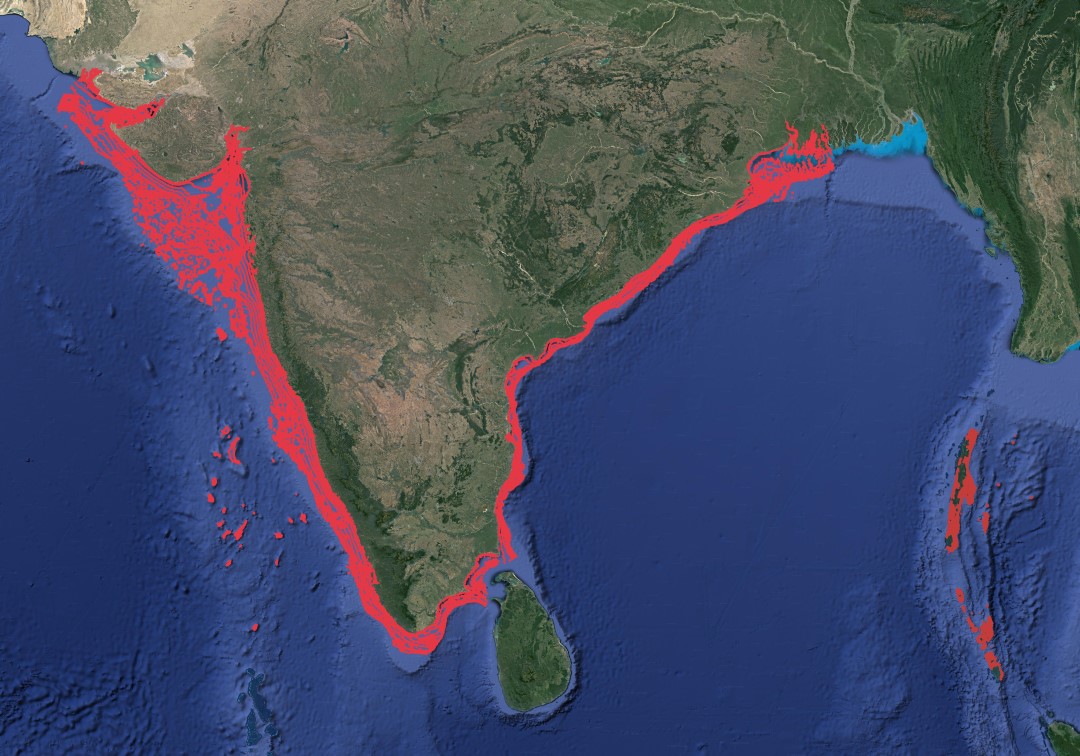Species Name
Blacktip Reef Shark
Scientific Name
Carcharhinus melanopterus
Family Name
Carcharhinidae
IUCN Status
Vulnerable
A medium-sized body with a snout that is short and bluntly rounded. Prominent black tips on all fins with a light band extending along the flank from the anal fin to just about the pectoral fins.
Biology
Length: Most adults are less than 5.25 ft [1.6 m] total length. Males mature at 3 to 3.25 ft [91 to 100 cm] and attain a length of 5.9 ft [1.8 m]. Females mature between 3.15 and 3.7 ft [96 and 112 cm], and may reach a length of 4.3 ft [1.3 m].
Gestation period: 8 to 9 months
Littter size: The litter size of the blacktip reef shark can vary but generally ranges from 2 to 4 pups per reproductive cycle.
Life Expectancy: The average life expectancy is 10 years (males) and 15 years (females).
Diet: The blacktip reef shark is carnivorous and primarily feeds on a variety of small fish, crustaceans, and cephalopods. They are opportunistic predators and may also consume injured or weak prey.
Habitat and Distribution
Habitat: Carcharhinus melanopterus is primarily a reef-associated species and is commonly found near coral reefs, hence its common name "blacktip reef shark." These sharks prefer shallow, clear waters with depths ranging from the intertidal zone to about 100 meters (approximately 330 feet). They are well adapted to swim in the relatively shallow waters around coral reefs and use the reefs as a source of food and shelter.
Distribution: They have a wide distribution range in tropical and subtropical waters of the Indo-Pacific region. Their range spans from the Red Sea and East Africa (including the Gulf of Aden) to the central Pacific, including the Hawaiian Islands. They are commonly found in the coastal waters of Southeast Asia, the Indian Ocean, and the western and central Pacific Ocean. Notably, they are often seen in the waters of Australia, Indonesia, the Philippines, Malaysia, and Thailand, among other countries in the region.
Known landing centres: Sassoon Docks, New Ferry Wharf, Visakhapatnam Fishing Harbour, Nagapattinam, Periyathalai, Thoothukudi, Threshpuram, Tharuvaikulam, Vembar and Vellapatti, Junglighat, Burmanallah, Wandoor, Dignabad, Cochin Fisheries Harbour and Kakdwip.
Depth: The blacktip reef shark is known for its affinity for shallow waters, especially those around coral reefs. They are frequently observed in waters as shallow as a few feet to about 100 meters (approximately 330 feet) deep. These sharks often spend much of their time in waters less than 30 meters (approximately 100 feet) deep, where they hunt for prey and navigate the reef ecosystem.
Commercial Value
Utilised for fins, meat and liver oil but have limited. They are important in aquaria and for dive tourism.
Threats
Vulnerable to negative impacts of fishing pressure and habitat destruction.
References
- Chin, Andrew & Simpfendorfer, Colin & Tobin, Andrew & Heupel, Michelle. (2013). Validated age, growth and reproductive biology of Carcharhinus melanopterus, a widely distributed and exploited reef shark. Marine and Freshwater Research. 64. 965-975. 10.1071/MF13017.
- Compagno, L.J.V., 1984. FAO Species Catalogue. Vol. 4. Sharks of the world. An annotated and illustrated catalogue of shark species known to date. Part 2 - Carcharhiniformes. FAO Fish. Synop. 125(4/2):251-655. Rome: FAO.
- Mourier, Johann & Mills, Suzanne & Planes, Serge. (2013). Population structure, spatial distribution and life-history traits of blacktip reef sharks Carcharhinus melanopterus. Journal of fish biology. 82. 979-93. 10.1111/jfb.12039.


Related Species
- Tiger Shark
- Silky Shark
- Common Blacktip Shark
- Spot-tail Shark
- Milk Shark
- Spadenose Shark
- Bignose Shark
- Blackspot Shark
- Blue Shark
- Broadfin Shark
- Bull Shark
- Dusky Shark
- Ganges Shark
- Graceful Shark
- Grey Reef Shark
- Grey Sharpnose Shark
- Hardnose Shark
- Sliteye Shark
- Silvertip Shark
- Sharptooth Lemon Shark
- Sandbar Shark
- Pondicherry Shark
- Pigeye Shark
- Oceanic Whitetip Shark
- Irrawaddy River Shark
- Speartooth Shark
- Spinner Shark
- Whitecheek Shark
- Whitetip Reef Shark

